|
Learn about Mongolia, by reading Mongolia – Wishing For More Time by Jerry Fogle, World Traveler and WTA Member. It features a mini, but thorough tour of the destination, plus all you'll need to know to plan your trip including getting there, objective information on places to stay and eat, and things to do. At the end of the article, we've provided a summary of the contact information for your easy reference. Enjoy!
Mongolia – Wishing For More Time
By Jerry Fogle, World Traveler and WTA Member
Part 2 - Days Three and Four
The last full day in Ulaanbaatar (October 16) was clear and turned out to be the warmest of my visit. The temperature reached around 50 degrees F. and the wind was very light. My private tour guide and car arrived at about 9 am. The guide spoke fluent English and was a history buff. This turned out to be a good thing since he was very knowledgeable of how city landmarks were tied to Mongolian history. I told him what I had seen the day before, so he planned our trip to exclude those sites. We drove through the downtown area, starting our visit to must see sites, including:
Gandan Monastery – the main monastery and Buddhist center of Mongolia. The complex covers many city blocks and is away from the large, center city buildings. The main temple features a 90 foot tall, gold-plated statue of Avalokiteshvara and thousands of small idols donated by the faithful followers. It is very colorful, interesting to see, but not meaningful to anyone who is a Christian. Our guide took us into the portion of the monastery where the public is allowed to see the Buddhist monks. At the time of our visit, they were having a meal of meat flavored milk and some sort of bread. They would stop eating when someone would start a chant which eventually became very loud while all were participating. The chant would wind down in volume and pitch until it stopped. We were allowed to walk around the monks who were sitting in a large square which had a statue of Buddha in the center. I saw one of the head monks write a note which was passed to a young monk, who in turn went to perform a ritual of serving the other monks. After a brief 5 – 10 minute stay we departed this area, walking backwards from the statue of Buddha as we exited. The guide said that while in the presence of the monks, we could not leave with our backs toward Buddha.
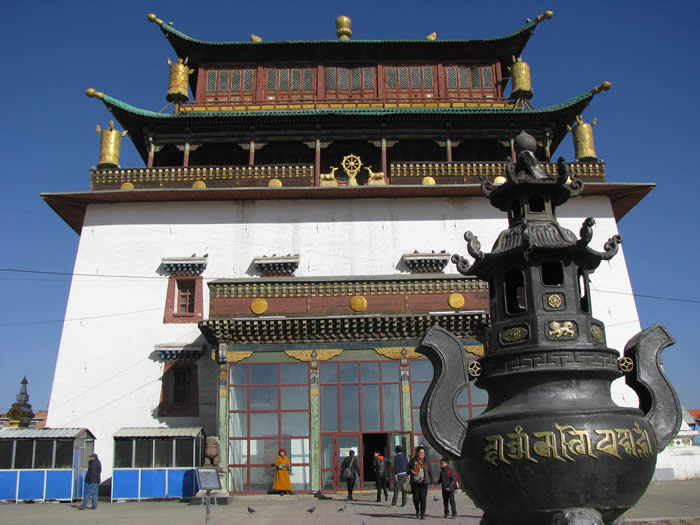
Gandan Monastery
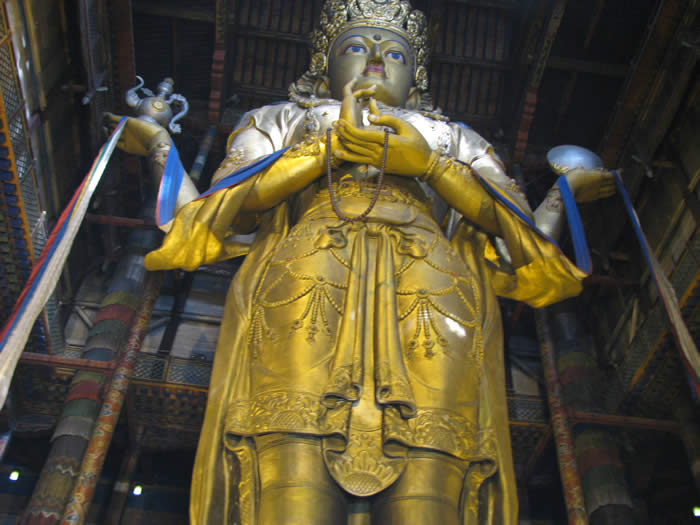
Statue of Avalokiteshvara
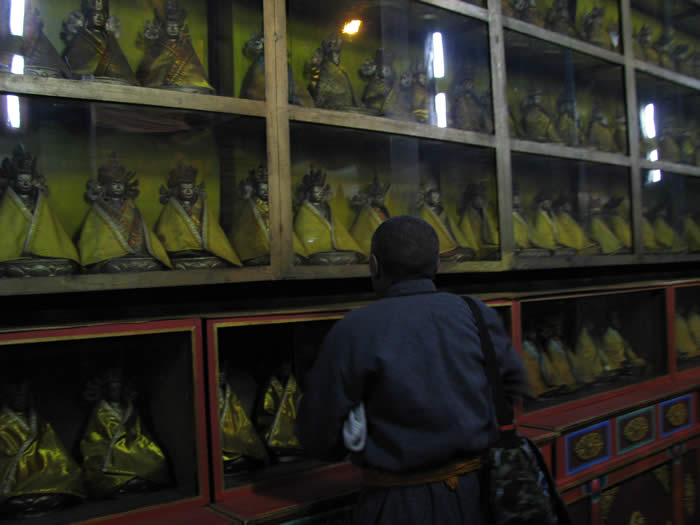
Thousands of small idols donated by faithful followers
Zaisan Memorial – The memorial is located high above the southern edge of the city, dedicated to Soviet-Mongolian friendship, Soviet Red Army and WWII heroes. There are steps from the parking area which take about ten minutes to climb to get to the memorial. The view from this landmark offers a panoramic view of Ulaanbaatar with ample opportunities for picture-taking. While the persistent smog from the coal-burning power plants obscures some of the view, it was clear enough to record some beautiful images. It was clear from seeing the city from above that while the streets and boulevards are wide, there are too few streets to handle the number of vehicles. The guide said that cars with even and odd numbered license plates had a day each week when not allowed to be on the streets. He also said that the number of vehicles had sky-rocketed over the last ten years. The main east-west streets were very busy, especially in the city center. The north-south streets were not as busy except for the area around Suhbaatar Square.
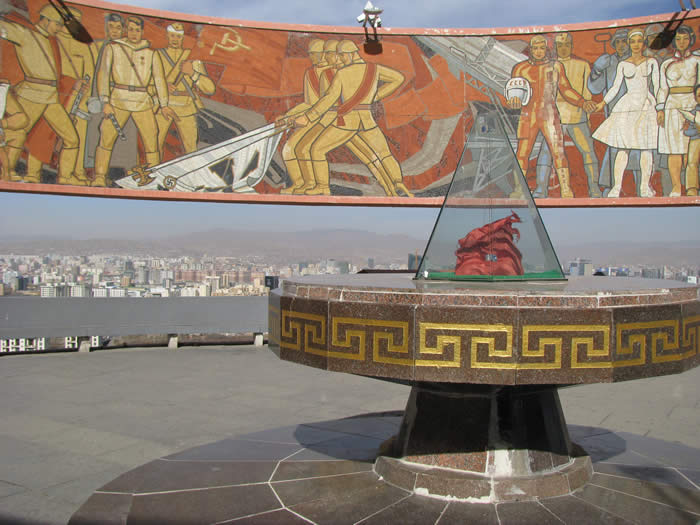
Zaisan Memorial
Dedicated to Soviet-Mongolian friendship, Soviet Red Army and WWII heroes
Bogd Khan Winter Palace Museum – The royal residence for the king and queen during the 1800s and early 1900s is worth seeing for its collection of Buddhist paintings and sculptures. While the condition of the buildings at this site is deteriorating, the architecture is distinct for the period and includes very colorful features. The artifacts and clothing displayed give the visitors a good feel for the life of the royals during the long winter on the edge of the city. This site was chosen for its proximity to the Tuul River near the southern edge of the city. This river supplies the city with water and allows the few trees and greenery to survive. Since the country averages only 8 inches of precipitation a year, this water is essential for all aspects of life in Ulaanbaatar. After leaving the museum, we walked across the bridge over the Tuul and took some pictures.
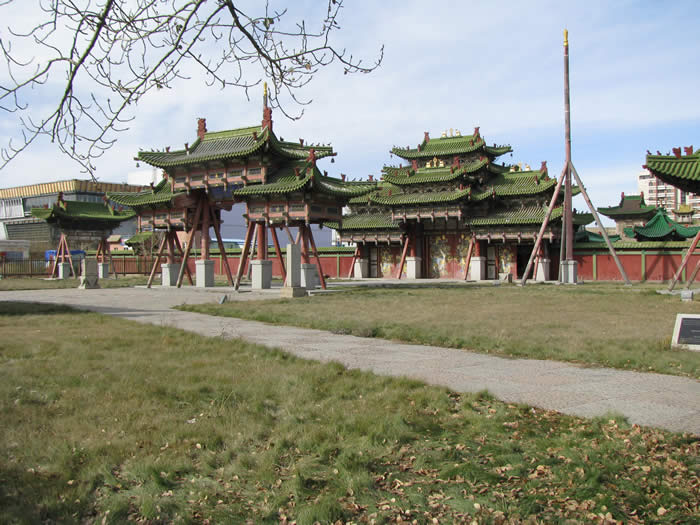
Bogd Khan Winter Palace Museum
We took a late lunch break at a local restaurant, a real Mongolian grill. With some help from my guide, we put together a good variety of meats and vegetables which were cooked on an open grill while we waited. The meal was tasty and included a dessert. I found this to be a better way to sample the local food.
We continued our tour by traveling to an area north and west of the Gandan Monastery where an endless number of Ghers can be seen. 80% of the population of Ulaanbaatar live in this vast area north of the city center. Many of the structures are Ghers and some are poorly constructed homes made from wood and other natural materials. Every few blocks, there are small buildings that have city water supplied by pump. Very few if any of the Ghers or other structures in this area have water or sewage. Some of the homes had outhouses, shared with other people. The guide said to be discreet in taking pictures and I understood what he was saying considering the poverty in the area. I tried to imagine what it is like to live on the open plains in Mongolia during the winter in a Gher heated by coal and wood. The central stove vents to a conical shaped roof, but smoke actually leaves through the felt walls and ceiling which “breath” fresh air while allowing toxins to escape. With winter days only 7 hours long, there would a lot of time spent by the fire cooking, doing indoor chores and waiting for warmer weather. These structures are used over a wide area of the country and reflect the nomadic life dominant in the history of the country. I departed this area with a true sense of the average person’s life where many struggle to survive the climate and depressed economy. This is in stark contrast to the modern, affluent city adjoining this area.
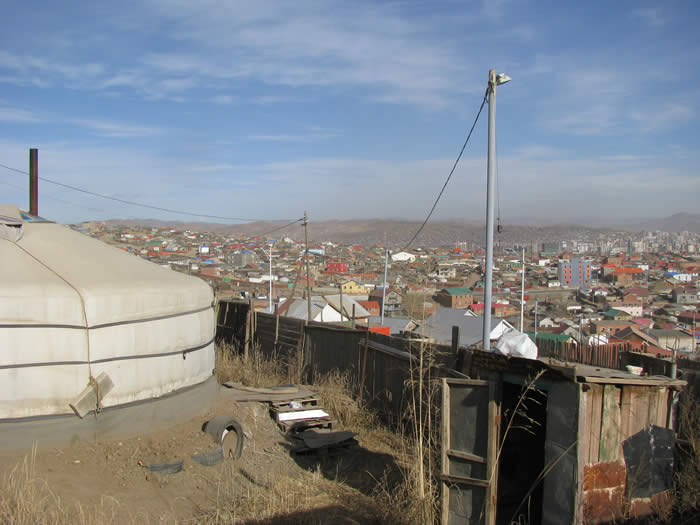
Ghers and other structures
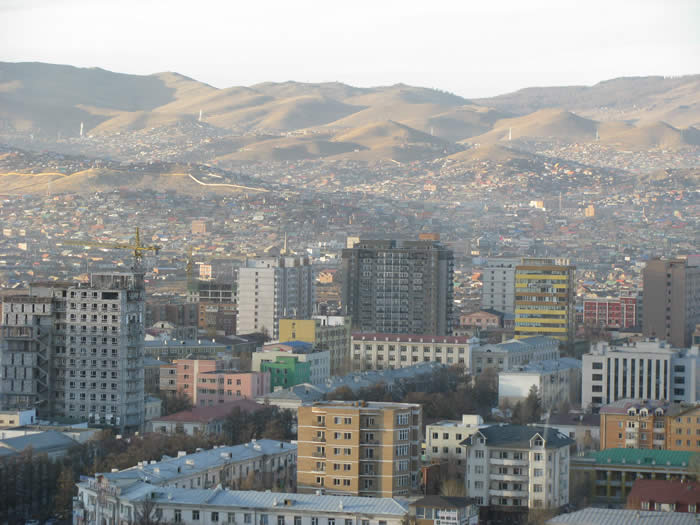
Northern area of Ulaanbaatar
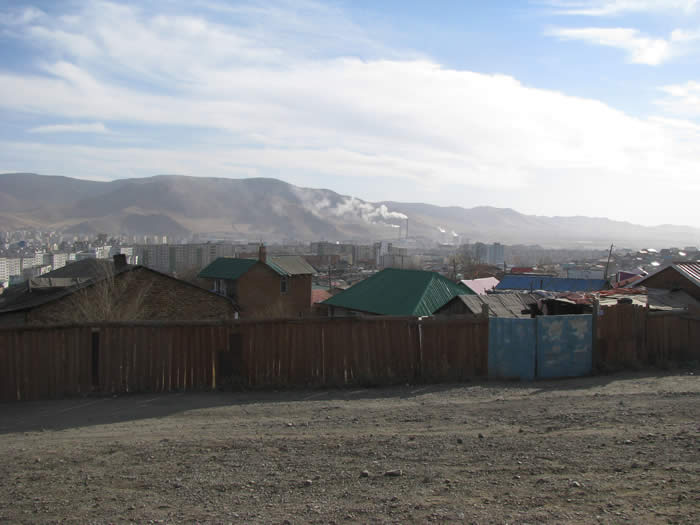
We concluded the full day tour with another stop at the Government House in Suhbaatar Square. Inside on the lower level, there are artifacts, historical Mongolian clothing, beautiful works of art depicting their fearless hero, Chinngis Khaan, in scenes of battle, and large colorful maps showing the progression of Mongolian history. There were also many photographs of Mongolian leaders starting in the early 1900s. These were interesting because traditional clothing was still worn (at least when pictures were being taken) by the leaders. I highly recommend visiting this level of Government House. This was the best collection of artifacts from the pre-Mongolian dynasty through modern times that I saw during my visit to the country. This full day tour was US $160 per person and, considering the one-on-one nature of the tour, was well worth the cost.
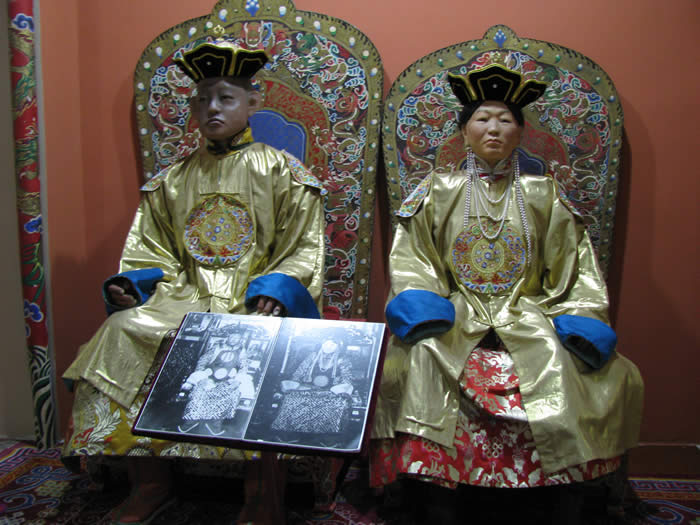
Traditional ceremonial clothing
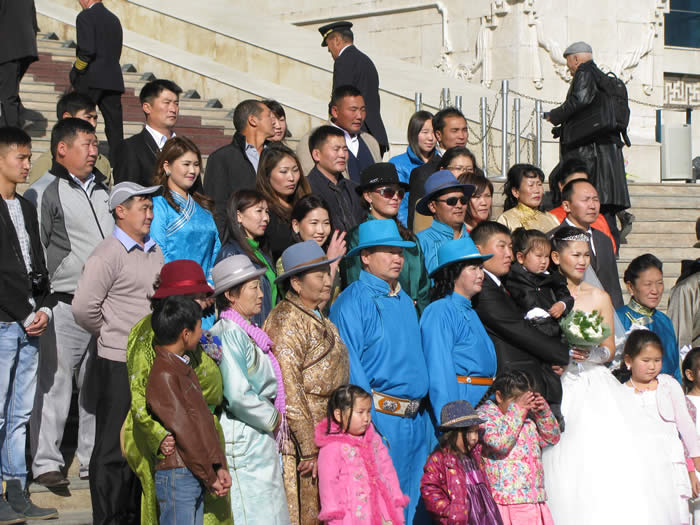
Traditional clothing worn at weddings
I decided to have dinner at the Japanese Teppanyaki restaurant on the second level of our hotel. The restaurant has many tables with grills where dinners are prepared by your waiter. I ordered steak from Australia pre-cut and cooked on a table grill nearby. The dinner included soup, salad, and fried vegetables, chop sticks used for everything except the soup. The food was excellent, the steak was tender and was prepared to order. The restaurant has a wide selection of wines and beer, including local brews. Service was good and the waitresses, dressed in traditional Japanese garb, were very courteous.
On Friday, the longest day of the trip, I left the hotel by taxi and traveled to Ghinngis Khaan Airport. I found the check-in and airport staff to be a throw-back to the Soviet era. Not one person during this process smiled, including the China Airlines personnel. Nonetheless, the process only took about 10 – 15 minutes and the airport did have a cozy coffee shop and gift shop. The waiting areas were furnished like something from the 1960s but had plenty of seats. There are so few flights from the airport that it would be difficult to get on the wrong flight. There are 4 gates and only 1 flight at a time arriving or departing.
The flight to Beijing was on time and my window seat allowed me to see the countryside in Mongolia, mountains north of the city, and the vast layout of apartment/condo complexes built by the Chinese government. I was amazed at how many structures there were, most seemed to be public housing. I did not see many neighborhoods with single family homes. Beijing International Airport is immense but fairly easy to navigate, signs are in Chinese and English.
My return trip took a bad turn when I arrived at the transfer desk for United Airlines. My non-stop flight to Washington Dulles had been cancelled and I was given a choice to fly to Newark, New Jersey and connect to Dulles or stay another day and hope the Dulles flight operated the next day. I opted for the inconvenience of making the additional connection. Anyone who travels routinely is familiar with this drill and an attitude of flexibility is required to get to your destination. United Airlines gave me an additional 17,500 miles in my Mileage Plus account (their frequent traveler program) for my inconvenience.
As I reflect on this trip to an area visited by few, I was glad to have had the opportunity to see the country, no matter how brief. The timing was good because the summer tourism season was over and prices on everything were good for visitors. I have been on many trips to foreign destinations and have had short stays in most due to future jobs scheduled, upcoming holidays, etc. I will repeat my earlier recommendation, if you decide to travel to Mongolia as a tourist, it is worth the time. You will see things you don’t see elsewhere. If possible, plan extra time for trips outside the main cities. Make sure to see the Gobi desert up close and the numerous national parks with mountains, valleys and beautiful scenery unspoiled like few places on Earth.
The experiences on this trip left me wishing for more time.
Read Part 1 – Days One and Two, Mongolia - Wishing for More Time
Details
Where to Stay
Kempinski Hotel Khan Palace
East Cross Road and Peace Avenue
Ulaanbaatar, Mongolia
Phone:
976 11 463463
Website:
reservations.ulaanbaatar@kempinski.com
Things to Do
Tour guides through hotel or directly at:
Juulchin Tourism Corporation
Olympic Street, 8
Ulaanbaatar 14-253, Mongolia
Phone:
976 11 328428
Email:
info@juulchin.com
This company provides free, easy to read street maps of Ulaanbaatar and Mongolia including points of interest.
Notice: This information is current as of February 2015. It is recommended that you contact the numbers, and/or visit the websites above to determine any changes to the information.
|